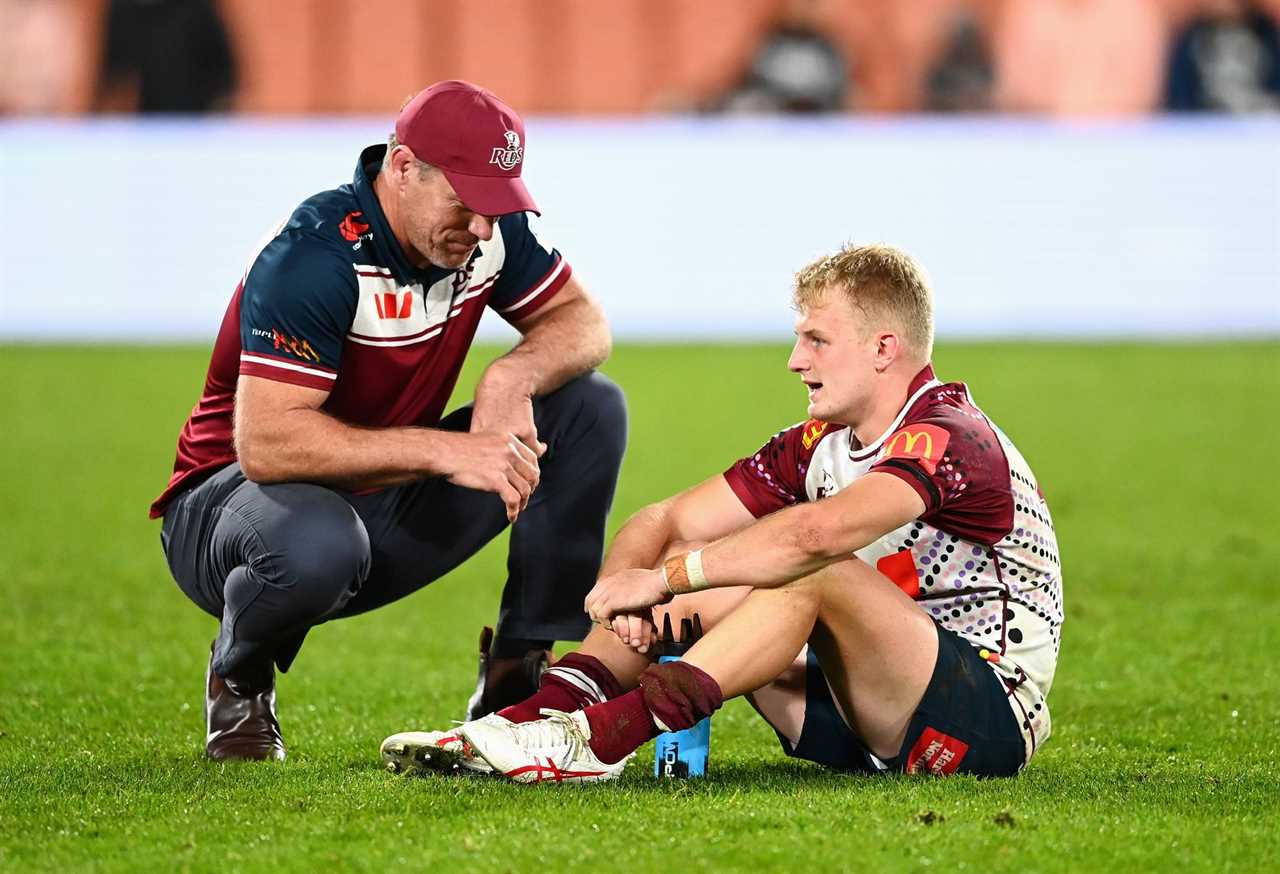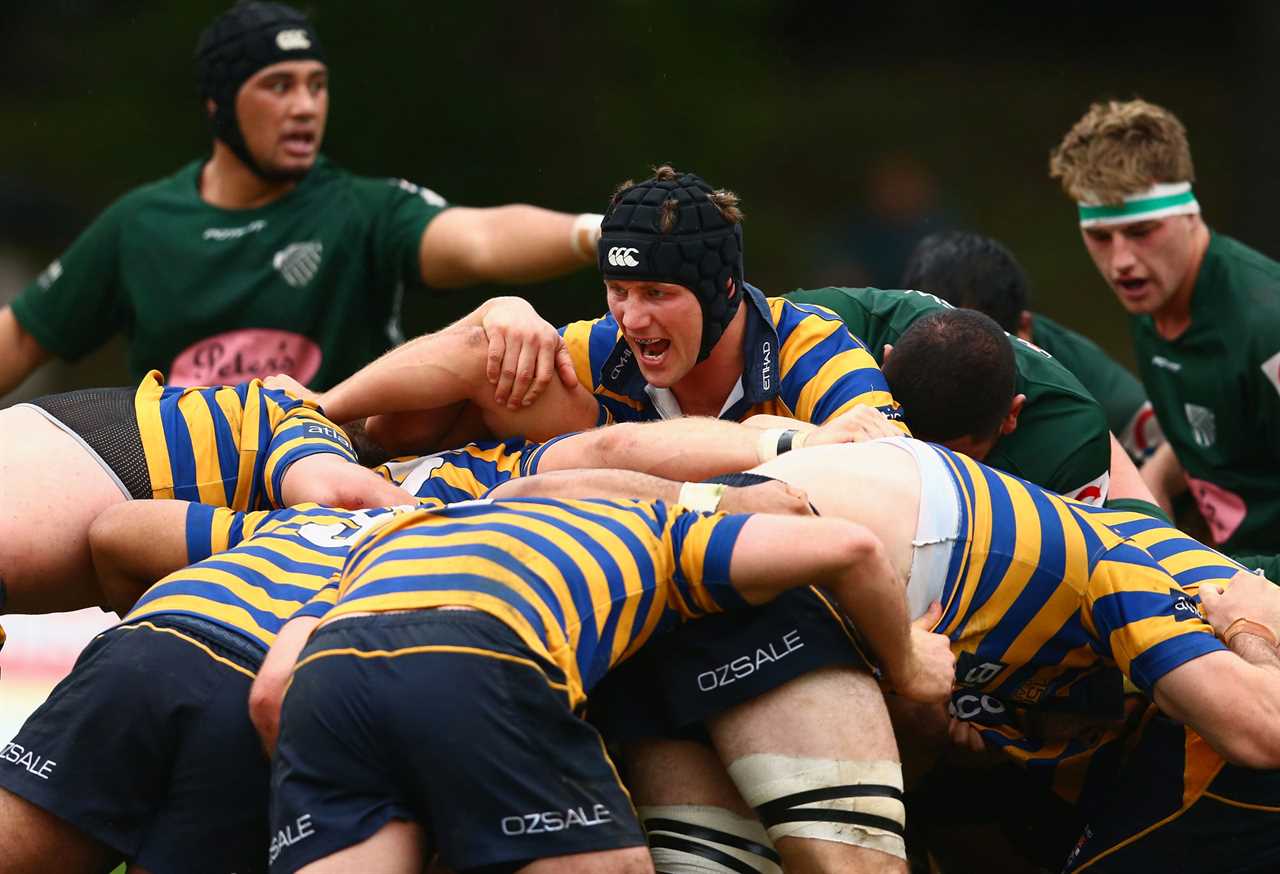Let’s call it what it is: 2023 has not been a good year for Australian rugby. When it rains, it pours, and fans have been subjected to striking out early in Super Rugby (again), an erratic first year of Eddie Jones with explosive conference after conference, and an all-time low for the Wallabies at the World Cup, and indeed, in the professional era.
A winning record lower than 25% doesn’t sit well. But, the grim part is fans don’t see a way out of this rut Australian rugby is in. Is there any light on an especially dim horizon?
It is easy to forget that while the Wallabies struggle in France, we are deep into the off-season for Australia’s Super Rugby franchises. The discussion of what our professional group of players do for the rest of the year when your season ends in July is a fair question to ask.

HAMILTON, NEW ZEALAND – JUNE 10: Reds coach Brad Thorn Tom Lynagh of the Reds during the Super Rugby Pacific Quarter Final match between Chiefs and Reds at FMG Stadium Waikato, on June 10, 2023, in Hamilton, New Zealand. (Photo by Hannah Peters/Getty Images)
For me, this is what makes covering Australian rugby at lower levels by far the most interesting part of our game: you see the germ of the problem, the issues that stem from a lack of game time, cohesion and more. While competitions like the NRC have attempted to fill that gap and there is a recognised appetite from coaches and players to bring it back, such competitions are likely not on the agenda for Phil Waugh and company, who are opting to extend the club season with a proposed competition.
So, with those options off the table for a competition like the NRC (a seven round regular season), or Super Rugby AU (an eight round regular season), how are our Super Rugby sides and players filling in the gaps to ensure the issues of 2023 aren’t repeated?
For reference, an NPC season in New Zealand enjoys a nine round regular season on top of a fourteen round regular season in Super Rugby Pacific, a guaranteed 23 games a year, excluding finals.
South Africa has a similar number, with the URC enjoying an eighteen round regular season. With a three month overlap from March-June with the fourteen round Currie Cup Premier Division, professional players in South Africa can be guaranteed AT LEAST 25 games a year, excluding finals. And don’t even get me started about how much game time players in Europe are getting.
Currently, Australian rugby ranks far below all of these teams, with a professional non-national representative player getting just fourteen games in Super Rugby Pacific, plus the back end of any club seasons games. Most players will be lucky to get 20 matches, and it is currently clear that, while the quality of Australia’s club competitions is strong, the gap between them and the professional level is now too great.
Make sure of your place in the stands to see the British and Irish Lions in 2025. Tour packages on sale now at Wallabies Travel
This lack of game time contributes to many things: lack of cohesion and weaker combinations, struggling for ftiness in the back half of games, effectively utilising tactics and eyes up rugby: essentially, a lot of the things many Australian players have been struggling with in comparison to our Super Rugby and international counterparts. It’s these gaps our Super Rugby sides are trying to fill.
The first option, for many players, is to find game time elsewhere, and go on loan into other competitions. On the face of it, barring injury, it isn’t a bad idea: the player stays match fit and gets game time, and can bring knowledge and skills back to their Super Rugby club. The most obvious competition running in the area is the NPC. So how many Australian players are actually playing there right now?
Currently, seven Western Force players, two Brumbies, three Rebels and one from the Reds played in this current season of the NPC, leading to thirteen players from five Australian sides overall. In comparison to a team like Moana Pasifika, who on their own have thirty five players (nearly their entire squad), it does make you think how little that competition is under-utilised from an Aussie perspective.
Many might say, we shouldn’t rely on the Kiwis to prop up our players, we need to find some other means to fill in the gap. This is something that four out of the five Australian franchises have attempted, by going on international tours with development squads.
In principle, these are strong too: the Brumbies are set to embark on a two match series in Japan against Suntory Sungoliath and Black Rams Tokyo this month. The Rebels will also to the land of the rising sun, embarking on an exhibition tour that culminates in a match against the Hanazono Kintetsu Liners.
The Queensland Reds, on top of their two match internal Challenger Series throughout September, will be welcoming the Saitama Panasonic Wild Knights to Ballymore in November. The Western Force are in the midst of a four match series with the Currie Cup-winning Cheetahs, which wraps up this weekend in Claremont.
These tours will see those four franchises play a combined total of ten games, which, while better than nothing, pales in comparison to 77 matches we’ll see in the NPC. It is a solution and is something that should be encouraged, but it’s not necessarily going to help with long term player development.

(Photo by Mark Kolbe/Getty Images)
Well, what about at home? If the NRC is off the table, finding ways to extend the club season can also be utilised, which is something RugbyWA have attempted this year. After going through a significant structural revamp, the Fortescue Premier Grade kicked off with a 22 round regular season, four rounds longer than the likes of the Shute Shield and Hospital Cup.
Even though many Force players were in and out of clubland due to the Cheetah tour, and the impact on lower grades is still up for debate, this resulted in a generally more balanced competition that gave players in the West much more game time. By playing more, the West look set to start to develop more and more local talent, fulfilling a long term goal for the Force to have a homegrown team for the success of the sport in the West. They are prepared to invest where they can to ensure that happens.
You may have noticed that in this article, there is one Super Rugby franchise that has been missing from this article, that being the Waratahs. Aside from coverage of the U/16 and U/19 pathway competitions and the Australian Rugby Shield, the Waratahs have been relatively silent on the games front since the conclusion of the Shute Shield on August 26th. No mention of any tours, no players on loan overseas, nothing outside of Waratah representation for both national teams. Nothing, that is, with the exception of the seismic shift news that the franchise may soon be under the control of RA.
Aside from a few trails ahead of the 2024 season, will that be it for the men in Sky Blue? Just training on the paddock and the gym? I’m definitely not a professional player, but I do know actual game time is miles better than any preseason drill.
Most Aussie Super Rugby franchises are trying, to some level or another, to prepare for 2024 in this off-season. While I appreciate their efforts and these tours will be beneficial for our players, you don’t have to look far to see that this will not be enough in comparison to our Kiwi compatriots when the first match kicks off on 23rd February, 2024.
It is clear we need to find a solution to the lack of game time our players face. If we are to turn the Australian rugby ship around, we need to find a long term, sustainable solution to not only look after our players in the middle of the season, but to ensure they are best equipped to succeed with a solid pre-season.
If we don’t, the dim light at the end of the tunnel for Australian rugby will continue to stay dim.
https://www.theroar.com.au/2023/10/12/is-there-any-light-on-the-horizon-what-the-super-rugby-franchises-are-up-to-in-the-off-season/
 Backyard GrillingWeekend WarriorsAdvice from DadBeard GroomingTV Shows for Guys4x4 Off-Road CarsMens FashionSports NewsAncient Archeology World NewsPrivacy PolicyTerms And Conditions
Backyard GrillingWeekend WarriorsAdvice from DadBeard GroomingTV Shows for Guys4x4 Off-Road CarsMens FashionSports NewsAncient Archeology World NewsPrivacy PolicyTerms And Conditions
